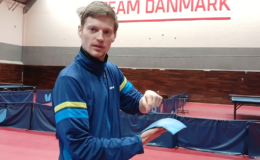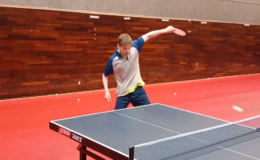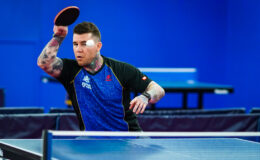By Larry Hodges, USATT Hall of Famer and Certified National Coach
Daniel from West Virginia emailed me the following question:
One of the things that I am struggling to understand is the relationship between rotation versus right-to-left leg weight transfer when looping. I saw in one of your earlier blog entries that you compare forehand looping with “rotating around a pole” that runs from the ceiling down to the floor. I’ve watched this video of Wang Liqin over and over and he seems to be generating most of his power with rotation rather than right-to-left leg weight transfer. Both of his feet stay pretty much rooted in the ground at all times during the stroke:
But whenever I watch counterlooping rallies between pros in an actual match, they do seem to be transferring their weight forward towards their opponent quite a bit, no?
In this video of Zhang Jike looping against underspin, I can see a large weight transfer onto the right foot, as evidenced by the fact that his left heel is off the ground when he initiates the stroke. This stroke seems to be slightly less about rotation and more about leg drive:
Does this mean there is a bigger transfer of weight onto the right leg when looping underspin than when looping topspin?
I’m not sure if any of this makes any sense, but if you could ever do a blog entry on the relationship of using rotation versus using forward momentum in generating power on the FH side, it would be really great. My stroke is really suffering as I’m just not confident in how to generate the racket speed right now.
This is an excellent question. The question basically is how much power should a player generate from these three aspects: rotational energy, driving forward with the back leg, and driving upward with the back leg.
When looping against topspin or a block (i.e. any ball without backspin), you’ll mostly use rotational energy and pushing forward with the back leg; there’s little upward motion. From the Wang Liqin video Daniel links to above, you can see that Wang (3-time World Men’s Singles Champion) uses a lot of rotational energy, but his head doesn’t move a whole lot – he tends to keep the right-to-left body movement to a relative minimum as his body mostly rotates in a circle. The advantage of this is that it means his head and body ends only a short distance from where it started before the stroke, meaning he is almost immediately ready for the next shot. If your head and body move more from right to left (for a righty), you may gain some power, but you’ll be slower recovering for the next shot. You need to find the right balance. If you have as much natural power as a Wang Liqin, then you don’t need much right-to-left movement. But if you have more time, then the extra body movement will add to your power.
Here’s a video of Ma Long vs. Wang Liqin. Watch Ma Long (far side, currently #2 in the world, former #1) in the first point as he loops five in a row. (It’s replayed in slow motion.) Like Wang Liqin, he mostly uses rotational energy, but he also moves right-to-left for extra power, especially in the very first of his loops. Now jump to the point starting 50 seconds in, and watch Wang Liqin’s first two loops. (It’s also replayed in slow motion.) He gets great power, yet it’s almost all rotational energy – watch how little his head moves during the stroke. Now jump back to the point starting 23 seconds in (also replayed in slow motion), and you’ll see a series of Wang Liqin loops where he has far more right-to-left movement – now his head does move during the stroke. Why is this? It’s more a matter of not being in perfect position against these angled shots into his backhand, forcing him to go way around to loop the forehand.
So while you do want that right-to-left movement (for a righty) when looping for extra power, you want to focus on rotational energy, with the center of gravity kept well between the legs, and the head moving only a little bit. The main exception is when looping from way around the backhand side, where you often aren’t as far around as you might want, in which case you compensate with more right-to-left movement. (Which means a slower recovery, so you have to have fast footwork if you do this, or simply end the point with the first shot.) The other exception is when going for extra power, but as shown by Wang Liqin and Ma Long, that’s not always necessary.
Now look at the video Daniel linked to of Ma Long vs. the chopper (Joo Se Hyuk). Here Ma has to overcome the heavy backspin, and so much of his power is upward as he pushes up with his back leg. He’s not going for a lot of speed in most of these loops, and so there’s only minimal forward motion as he topspins away, mostly stroking upward and rotating in a circle, with his head starting and ending in almost the same place. (In some of the early loops, he is almost falling backward as he focuses almost totally on upward motion.) In the first point, he loops ten balls before missing the eleventh. The first eight are all basically steady loops (by world-class standards), where most of his power is going upward. Now look at the ninth loop, where he loops with much greater power into Joo’s backhand. Now there’s a sudden increase in right-to-left motion, with his head ending more to the left. This gives extra power. (And since he’s playing a chopper, there’s plenty of time to recover for the next shot.)
What does this mean for you? The most important thing is to stay balanced, especially when looping against a fast incoming ball. Focus on rotational energy, and add as much right-to-left movement (for righties) as needed. Many players find it a lot easier to end the point this way, and if the ball rarely comes back, then there’s no problem. At the higher levels, even these powerful loops often come back, and so recovery becomes an important issue – but at that level, players are so fast they can often get away with more sideways movement, relying on their footwork to recover for the next shot. But as shown by Wang Liqin and Ma Long, it is the rotational energy that is most important, and the rest is the extra spice often used for a little extra power or to compensate when forehand looping from way around on the backhand side.



